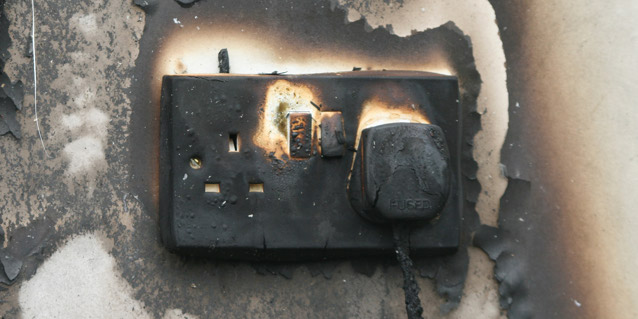EMA License: 9/21140 | Open 9am - 6pm | Monday to Saturday | Call 84193988

Case Study: March 2008, Jurong West HDB Electrical Fire
Another 2008 case of an electrical fire in Singapore was studied by the Singapore Civil Defense Force for a case study in fire prevention and attention. The study shows that there were several recorded cases of electrical fires within a single year, all originating from similar electrical faults and dangers.
A deeper look by CATS Singapore electrician services into the specific case of Jurong West in March of 2008 might bring to light some of the electrical faults that Mr. Li, the subject of the case, and his roommates were experiencing, which may have led to the electrical fire.
Case Study Details
An apartment held 6 occupants in a bedroom. Mr. Li was the first occupant to notice that there was a small fire under his clothing rack when he returned home. After shouting “Fire!” to his roommates, he alerted them of the situation.
Several of the other occupants attempted to put out the fire, but the water did not douse the flames. Instead, the fire begun to spread rapidly, destroying the mattresses and bedroom sets inside the room of origin. What’s more, the fire ate up the wooden partition separating the bedroom from the living room.
Mr. Li himself sustained several burn injuries when he attempted to remove his suitcase from under the bed, where the fire began. While his roommates were unsure what caused the fire, Mr. Li suspected that it was due to the portable electrical outlet that had multiple appliances plugged into it.
Was his suspicion correct?
What Was the Cause of the Electrical Fault?
Authorities determined that Mr. Li was correct in his detailing of the electrical outlet that caused the fire. The reason he and his roommates did not suspect the faulty appliances at first was because the appliances were not turned on. There was a standing fan and a microwave oven plugged into the portable socket, but neither of them were in use.
However, this does not pose any less of a danger for electrical fire.
The outlet itself was still turned to the on position, which means that an active electrical current was still running through it. This poses a great danger for an electrical fire. Unchecked sockets that are still turned on are just as dangerous as electrical appliances left on and running for long periods of time.
The most likely cause of the electrical fire was due to the fact that the portable outlet was unstable or faulty, leading to an overloaded current with the two appliances plugged into it. It was trying to attain more energy than it could handle, which resulted in combustion.
Why Do These Faults Occur?
These faults can occur easily, but measures can be taken to prevent them from happening. These faults most often occur because people do not realize that outlets must be turned off when they are actually not in use. Simply turning off the appliances plugged into them is not the safest way to control the electricity in your home.
These faults do occur often, but are preventable. In the case of the 2008 Jurong West electrical fire, the occupants of the home were not paying attention to their appliances and portable outlets. This is what caused a fire to spark from an unchecked current.
Safety Tips for Preventing These Kinds of Faults
As long as homeowners can properly maintain and inspect their electrical appliances, outlets, and wiring systems, they have a better chance of preventing something like the Jurong West electrical fire from occurring.
You should always make sure that you do not have multiple appliances running at once. And when it comes time to turn them off, make sure the outlet is turned off as well. You can do a simple routine maintenance check by looking at your power outlets and making sure that the switch is turned to the off position.
If you see any exposed wires, cracked cords, or loose outlet plugs, do not use the device. Faulty electronics are the number one cause of electrical fires in the home, and should be prevented at all costs.